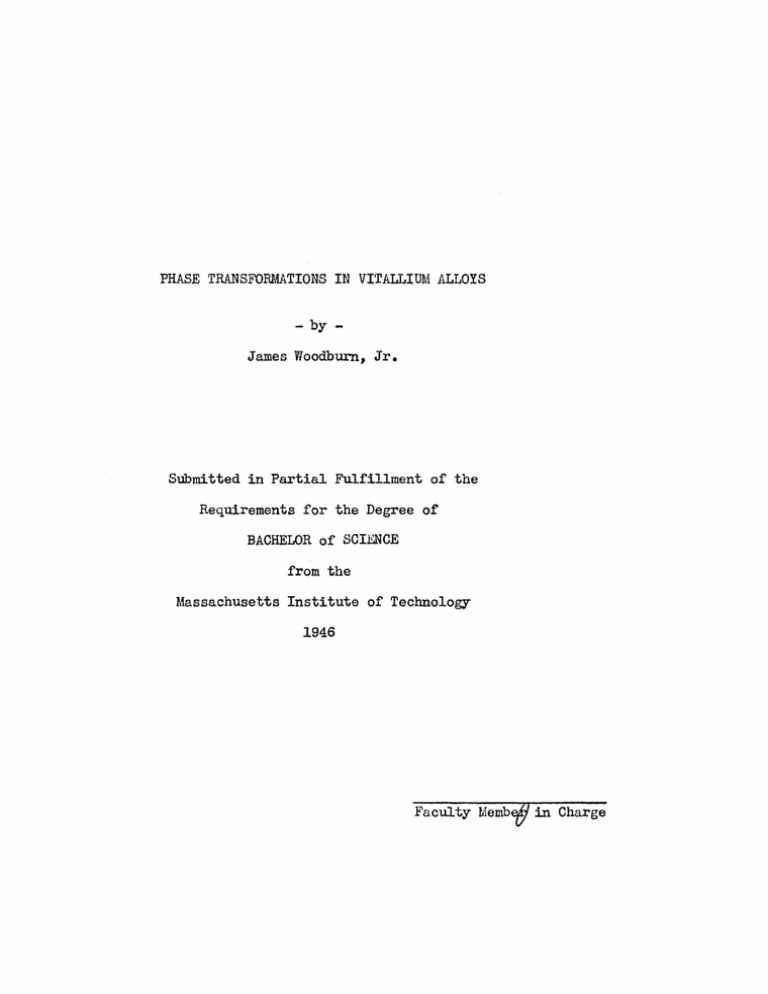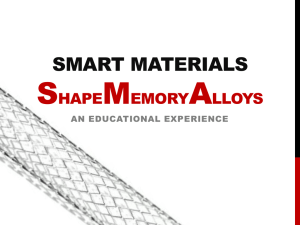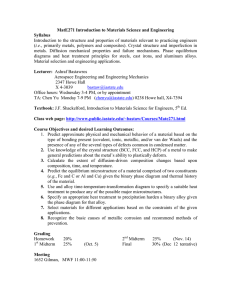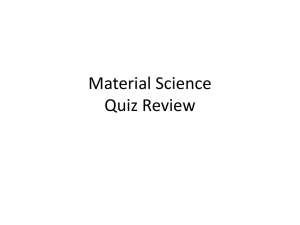James Woodburn, Jr. from the Massachusetts Institute of Technology 1946
advertisement

PHASE TRANSFOR.MATIONS IN VITALLIUM ALLOYS - by - James Woodburn, Jr. Submitted in Partial Fulfillment of the Requirements for the Degree of BACHELOR of SCIENCE from the Massachusetts Institute of Technology 1946 Faculty Member in Charge TABLE OF CONTENTS ACKNOWLEDGEM•ENTS INTRODUCTION ii SUMMARY iv DETAILS OF INVESTIGATION Alloy Composition 1 Construction of Moulds 1 Casting 2 Metallographic Examination 3 Dilation Studies 6 X-ray Diffraction Studies 8 Debye-Scherrer 8 Back-reflection 10 Summary of Results 11 Suggestions for Future Work 12 Bibliography 13 APPENDIX Cobalt-chromium System, Comparative Results Composition of Investing Material Photo-Micrographs Dilation Results, VT2-2 Dilation Curve, VT2-2 Debye-Scherrer Pattern, VT2-2 I II III IV V VI ACKNOWLEDGEMENTS: The author wishes to express his appreciation to Professors N. J. Grant and John Norton and to Mr. J. R. Lane for their advice and guidance on the subject of the investigation. - ii - Introduction During the past several years, much interest has been centered on the development of alloys which exhibit the properties of high strength and high corrosion resistance at elevated temperatures. This development was of major importance, first, for use in trubosuperchargers and, ,ater, in turbo-jet and gas turbine engines. One of the original alloys used successfully for exhaustturbine blades was Vitallium, a cobalt-base alloy usually containing between twenty and thirty percent chromium and smaller percentages of other elements. In simple cobalt-chromium alloys con- taining less than thirty percent chromium, the crystal structure at room temperature is hexagonal close-packed. At elevated temperatures, however, the structure transforms to a face centered cubic lattice. It was the purpose of this investigation to deter- mine if this transformation takes place in a Vitallium alloy, and, if the alloy is so stabilized by the presence of molybdenum and tantalum that no transformation takes place, to determine whether the hexagonal or the face-centered is the stable form. Up to the present time there have been no works published on the structure or properties of Vitallium. Several investigations have been carried out on the cobalt-chromium system, the comparative results of which are given in the appendix, page I. It can be seen that the investigators are not in complete agreement, but - iii - for the purpose of this work, the transformation temperatures as determined by Weber and Hashimoto were used as a basis from which to estimate the probable transformation temperature in the alloy to be studied. Summary: In order to study the structure of Vitallium, a cobalt-base alloy containing 25 percent chromium, 6 percent molybdenum, and 2 percent tantalum, three heats with carbon percentages of 0, .20 and .60 were prepared. These alloys were then subjected to (1) microscopic studies, (2) dilation studies, and (5) X-ray diffraction studies. The conclusions reached as a result of the above mentioned work may be summarized as follows: (1) The crystal structure of the solid-solution matrix is hexagonal close-packed with lattice constants a and c equal to 2.496 and 4.075 Angstrom units respectively. (2) This hexagonal structure is stable within the tempera- ture range studied, this range being from room temperature to 12000 C. (5) A precipitation at the grain boundaries begins at a temperature of 11100 F. This precipitate is not a carbide, as it formed in the alloy containing no carbon as well as the alloys containing carbon. Details of Investigation -1- Alloy Compositions The alloy to be studied was of the Vitallium type, designated as VT2-2, containing 25 percent chromium, 6 percent molybdenum, 2 percent tantalum and the balance cobalt. This composition was prepared with 0 percent carbon, .20 percent carbon and .60 percent carbon. Eight rods, 5 inches in length and - inch in diameter, were prepared of each of the three compositions. Because of poor machining characteristics of the alloy, the rods were prepared by the investment-casting method. Construction of Moulds The moulds were made by the lost-wax method. This process consisted of three steps, (1) forming the patterns, (2) investment of the pattern in a refractory material, and (5) removal of the wax by heating the mould. The patterns for the rods were made by injecting molten G. E. Brown wax into a metal mould. The rods were then attached at both ends to wheel-shaped wax patterns. A wax hot-top was at- tached to the pattern to form an entrance for the molten metal. Three patterns were made, consisting of eight rods per pattern. The patterns were then attached in an inverted position to flat metal plates, and were sprayed with a suspension of fine silica to give a smooth surface to the finished casting. The com- position of this spray is given on page II of the appendix. Following the spray, open end sheet iron cylinders, with a lining of asbestos and heavy paper, were placed over the patterns and the -2- joints between the cylinders and plates sealed with molten wax. The investing material (composition given on page II of the appendix) was packed around the patterns. The moulds were then placed on a shaking table to remove any air bubbles adhering to the patterns. After the investing material had dried sufficient- ly, the moulds were removed from the steel plates and the part projecting above the sheet-iron form was cut off. The moulds were then placed in a furnace and slowly raised to a temperature of 18500 F, during which the wax pattern was vaporized. Casting The alloys containing .20 percent carbon and .60 percent carbon were melted in an electric arc-furnace. In order to avoid the carbon pick-up associated with the arc-furnace, the alloy containing 0 percent carbon was melted in an induction furnace. The pouring temperatures of the three heats were approximately 14500 C. Prior to casting the moulds were heated to 18500 F to prevent the metal from freezing before the mould was completely filled. The casting was done under 10 pounds per square inch of nitrogen. After the moulds had cooled, the castings were removed and the rods cut from the end pieces with an abrasive wheel. The rods were then sand blasted and centerless ground to .247 inches in diameter. - 5 - Metalloraphic Examination The three carbon compositions were examined metallographically to determine if any changes take place upon heat-treatment of the alloys. First, the probable transformation temperature was estimated from the equilibrium diagrams of the cobalt-chromium and cobalt-molybdenum systems. This temperature was estimated to be 11000 C. Secondly, the specimens were water quenched from above the estimated transformation temperature in an attempt to transform all of the cobalt rich matrix to the face-centered cubic phase. The specimens were held at 12000 C for one hour. Thirdly, the quenched specimens were aged over a range of temperatures for a period of 48 hours. The temperature range examined was from 5000 C to 10000 C. Examination of the 0 percent carbon alloy in the as-cast condition showed a two phase structure. The matrix was assumed to be a cobalt rich solid solution, the second phase was not identified. The medium and high carbon specimens showed the same structure, bub in addition small carbide particles were seen. The grain boundaries could not be seen in these specimens. The 0 percent carbon specimen quenched from 12000 C and aged for 48 hours at 5000 C showed a two phase structure similar to that of the as-cast specimen. The cored effect due to the nonequilibrium conditions prevailing during solidification of the metal was still evident. No grains could be seen in the specimen. The specimen aged at 6000 C was similar to the specimen aged at -4- 5000, except that the typical cast structure had disappeared. In the specimen aged at 7000 C, the grain boundaries were clearly visible, the grains being outlined by an aging precipitate at the grain boundaries. In the specimens aged at 800 o C and 9000 C, this precipitation was even more pronounced. The specimen aged at 10000 C showed evidence that the precipitate was going back into solution, as the grain boundaries were not as heavily outlined as in the previous cases. The progress of the precipitation in the 0 percent carbon specimens can be seen in the photo-micrographs on page III of the appendix. All exposures were made at lOOx magnification, the specimen being etched electrolytically with a 4 percent HU1 solution. Specimens of the .20 percent carbon and .60 percent carbon alloys were given heat-treatments identical to those given the 0 percent carbon specimens. In both cases, precipitation began to take place between the temperatures of 6000 C and 7000 C. In the specimens containing carbon, however, the precipitation was not as pronounced as in the 0 carbon specimens. To summarize, the following conclusions were reached as a result of the investigation: (1) In the zero percent carbon alloy there are two phases present, a cobalt rich matrix and small particles of a yet unidentified phase. In the alloy containing carbon, the same two phases are present, and, in addition, carbide particles of unknown composition. -5- (2) No changes could be detected in the matrix of the specimens, either after quenching or during the aging treatments. This was true of all specimens examined. (5) A precipitation at the grain boundaries began between the temperatures of 600o C and 7000 C in the 0 percent carbon alloy, the .20 percent carbon alloy, and the .60 percent carbon alloy. This would indicate that the precipitate is not a carbide. -6- Dilation Studies Dilation studies were made of the alloy containing no carbon. The dilatometer specimens were first quenched from 12000 C in order that the full effect of the aging precipitation could be observed. The specimens were then cut to a 2 inch gauge length. The temperature was measured with a platinum, platinum-rhodium thermo-couple with the reference-junction at 520 F. The change in length of the specimen was measured by means of a Ames dial gauge reading to the nearest .0001 inch. In all three runs were made up to a temperature of 15000 F. Only the results of the third run are reported in this paper, as there were large discrepancies in the results of the first two runs. The results of the third run are given on page IV of the appendix, and the plot of temperature versus dilation on page V of the appendix. From the dilation curve no evidence .of a phase transformation can be detected. A sharp change in the slope of the curve can be seen at a temperature of 11100 F. This break is interpreted as marking the beginning of the precipitation at the grain boundaries. A similar change in slope was observed in the first two runs, the break occurring at temperatures of 11•00 and 11200 F respectively. To summarize: (1) There is no evidence of a phase change in the matrix up -7- to a temperature of 15000 F. (2) A break in the curve occurs at a temperature of 11100 F, which is thought to be the beginning of the precipitation observed in the micro-scopic examination of the alloys. -8- X-ray Diffraction Studies The purpose of these studies was to determine the crystal structure of the solid-solution matrix and to see if any change in this structure takes place upon heating to elevated temperatures. To accomplish this purpose both powder and solid sample methods were used. Debeye-Scherrer Patterns In order to identify the lattice structure of the matrix of the alloys, diffraction patterns were obtained of powder samples of the alloy containing no carbon. The zero percent carbon alloy was selected in order that the pattern would not be further complicated by the presence of carbide lines. It was assumed that the structure of the matrix would be of the same crystal type regardless of the carbon content. The powder samples were obtained by filing the rods, the filings being screened to -200 mesh. To stress relieve the powder, it was sealed in an evacuated quartz tube and annealed. In order to obtain a complete pattern of lines of sufficient sharpness, it was found necessary to anneal the powder above the aging temperature of 11000 F. With this treatment, there is a possibility of extra lines appearing due to the precipitation which was discussed in the previous sections of the report. The best pattern was obtained when the powder was annealed for 24 hours at a temperature of 15000 F. Rods were then prepared from the annealed powders, and ex- -9- posures made of the rods using Chromium radiation and an exposure time of 45 minutes. Only the results obtained from the exposure made of the powder annealed at 1500o F are reported. These results are given on page VI of the appendix. An unsuccessful attempt was made to fit the sin 2e values into a face-centered cubic pattern. The values of sin 2e values were then compared to the Hull-Davey chart for hexagonal close-packed systems, and a very close correlation of the values was found at a c/a ratio equal to that of cobalt. The structure was assumed to be hexagonal. The 'c' and 'a' lattice constants were then calculated from the relationship: 1ia 4 h+ h K+ L The calculated values are, a=2.496 Angstrom units, and, c =4.075 Angstrom units, as compared to the values for pure cobalt of a=2.507 Angstroms and, c= 4.072 Angstroms. This close check of the lattice constants with those of pure cobalt gives further indication that the assumption of a hexagonal structure was correct. After elimination of lines resulting from the characteristic Beta radiation and identification of the hexagonal pattern, three lines remained unidentified. It was assumed that these lines were caused by the presence of a second phase as was noted in the microscopic examination. - 10 - Back-Reflection Studies X-ray diffraction patterns were obtained from the solid rods for all three carbon contents. Patterns were made of the rods in the as-cast condition and water quenched from 12000 C. Before the exposures were made, the rods were electrolytically etched in a 4 percent hydrochloric acid solution for 15 minutes to remove any surface strains caused by the grinding. The camera used for these exposures was of the back-reflection type. The film container was cylindrical, with a radius of 57.29 millimeters. Provision was made to the rod a combined rotary and translational motion in order that a maximum number of grains would be exposed to the X-ray beam. For all exposures Chromium radiation was used. Comparison of the lines obtained from the as-cast rods to the lines obtained from the rods quenched from 12000 C showed that there was apparently no change in the crystal structure within the range of temperatures investigated. This assumption was based upon three strong lines which appeared in the patterns of the 0., .20 and .60 percent carbon alloys in both the as-cast and quenched conditions. This conclusion is further strengthened by extensive back-reflection studies made under Professor N. J. Grant, in which the same results were obtained. It was hoped that the change in the position of the lines with varying carbon content would throw some light upon the type carbides present in the alloy, as an increase in refraction angle -11- would mean that a comparatively large atom had been removed from the solid solution by the carbon. The change in the position of the lines bore no apparent relationship to the carbon content or heat treatment. Summary of Results of X-ray Studies The following results were obtained: (1) The lattice structure of the matrix of the alloy is hexagonal close-packed. (2) There was no indication of a change of the matrix to face-centered cubic up to a temperature of 12000 0. - 12 - Suagestions for Future Work The author wishes to make the following suggestions for further investigation of this alloy system: (1) Confirmation of lattice structure and lattice constants reported in this paper. (2) Further determination of the degree of stability of this structure by quenching powder samples from elevated temperatures. (5) Identification of the crystal pattern of the unidentified lines observed in the Debye-Scherrer patterns. (4) Investigation of the effect of the precipitation at the grain boundaries upon the tensile strength of the alloy. -13- Bibliography M. Hansen, Aufbau der Zweitofflegierunaen , Berlin, 1936 Charles S. Barrett, Structure of Metals , New York, 1945 APPENDIX I' I z w 0 th w w 0 w z0IL w Iw a. hi 10 Ok *0t 20 30 Preparation of Spray For Wax Pattenns 1. Soap solution prepared from "Orvus" soap stock. 15 grams in 1 quart of water. 2. Composition of spray a. 55 cc. soap solution b. 15 cc. Sodium Silicate c. 5 cc. 10% Hydrochloric Acid d. 105 grams silica flour Preparation of Investing Material 1. To 4500 cc. of Tetra-Ethyl-Silicate add 1500 cc. Ethyl Alcohol and 100 cc. Water. bet the solution stand for 24 hours. 2. To 900 cc. of the solution prepared in part 1 add 100 cc. Water. Let stand 24 hours. 5. To the solution prepared in part 2 add an equal volume of Ethyl Almohol. This solution is then mixed with "Austenal" in the ratio of 790 cc. to 5000 grams "Austenal". material. This forms completed investing .* - ,, • . " ,I . ,I6€ . j. I.. ~5 .5 A , . ,. - ' , ., , .. .'. A ; ... -- , ~5 * .5. 44' 'II * ,515.5.5 -* aI, ,...* V ,.. .. : .. ., * . * .5 -, $ 4'. 4p S . 4- I - a. .. ' 5, ·_ VT -2 ;.-.," Water Quenched from 1200oC Aged 48hr. at 5000 C : l .' " .4- _ _ 5 Water Quenched from 12000C VT2-2 Aged 48 hr. at 60000 I • 0 "! l~• i Sb • ." . I " .5, te s. %. ,•" ,.,. --.• • . A 5~* II * U - '4 * .0 E... 0. 4 '4 54., 4 VT2-2 . p ~1~t .5 * -F...- WI * 5 . 5555 A * 1. Water Quenched from 12000 C Aged 48 hr. at 700 0 C ," . :.. . ... / .5.4 5 , .5' 44. VT2-2 ". .. , , Water Quenched from 120000 Aged 48 hr. at 800 0 C ... Dilation Data - VTHeat Treatment: 120000o 1 hr, Water Quench Initial Length: 2.008 inches Av. Heating Rate: 4OF per minute Temp. 0? 72 AL Temp. 0 F AL Temp0 'F _AL .0000" 862 .01203" 1575 .02035" 102 .00035" 884 .01242 1397 .02085 166 .0011 910 .01282 1427 .0215533 217 .00183 952 .01316 1442 .02175 250 .00224 954 .01355 1460 .02215 .00267 978 .01388 1480 .02265 .003352 998 .014153 1513 .02314 .00413 1019 .01458 1525 .02352 .00502 1044 .01465 1462 .02200 .00585 1066 .01485 1419 .02110 .00675 1085 .01497 1380 .02025 .00740 11035 .01517 1547 .01955 .00777 1124 .01565 1316 .01882 11435 .016035 1280 .01810 .00840 1162 .01638 1249 .01759 .00870 1191 .01695 1216 .01680 .00920 1208 .01728 1185 .01600 00970 1252 .01768 1154 .01534 00997 1253 01808 1119 .01470 1277 .01847 1087 .01405 .01065 1295 01885 1055 .01348 801 . 010935 1519 01922 1024 .01295 821 .)1132 1545 .01968 996 .01240 1561 - A1998 967 .01195 945 .01148 287 330 380 425 481 557 577 6035 650 650 668 703 751 745 763 782 838 .00805 01028 )1168 4~ý4 KT T I-T 4- T T ~IT -r - I-- -1 i~:ji~L 'i 4t~k~L44L T - -L t +~- Debye-Scherrer Pattern for VT2-2 Powder: -200 mesh, annealed 24 hrs. at 1500 0 F C-hromium, Wave-length = 2.28503 a.u. Radiation: Line S in mm. Intensity 0 Sin2o Beta Lines 1 50.7 Faint 50.8 .51204 2 51.0 7T 31.1 .51655 5 51.8 51.9 .52844 4 55.0 55.1 .54610 5 54.0 .56064 6 54.4 34.1 34,1 54.5 7 36.7 56.8 .59902 8 40.2 40.5 .64679 9 50.5 50.4 .77051 10 55.9 Faint 60.0 .82904 11 62.7 Very Faint 62.8 .88942 12 65.5 Strong 65.4 .90924 135 76.1 Medium 76.5 .97155 14 77.7 Very Faint 77.9 .97778 Strong 7' "n M.edium (100) (002) .56641 (101) (102) _ Calculated Results: a = 2.496 Angstrom munits b = 4.072 Angstrom units Miller Indices (Hexagonal) (110) _







